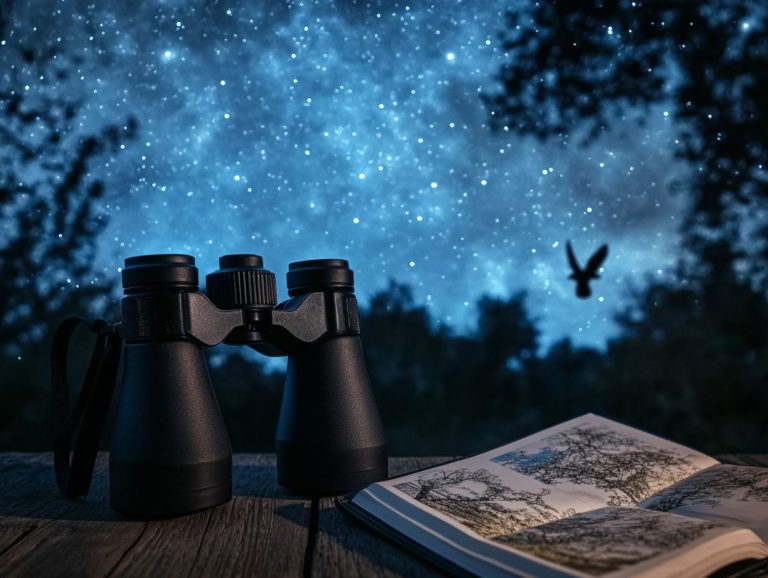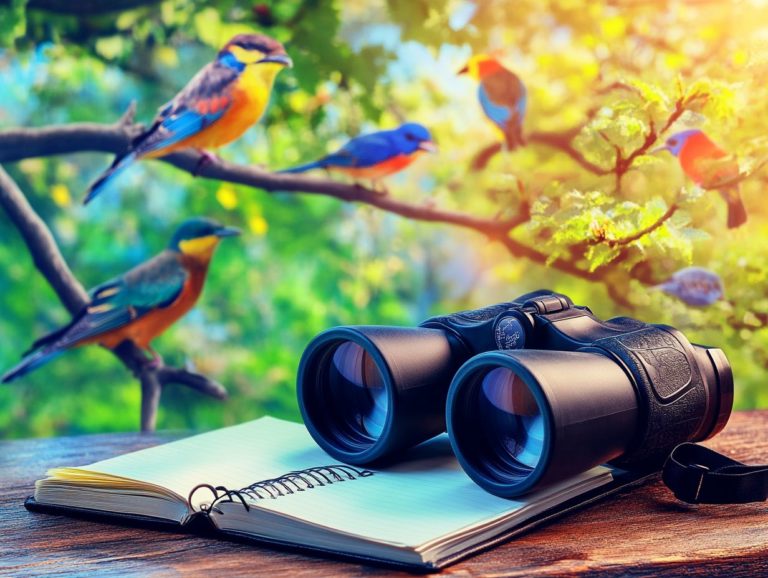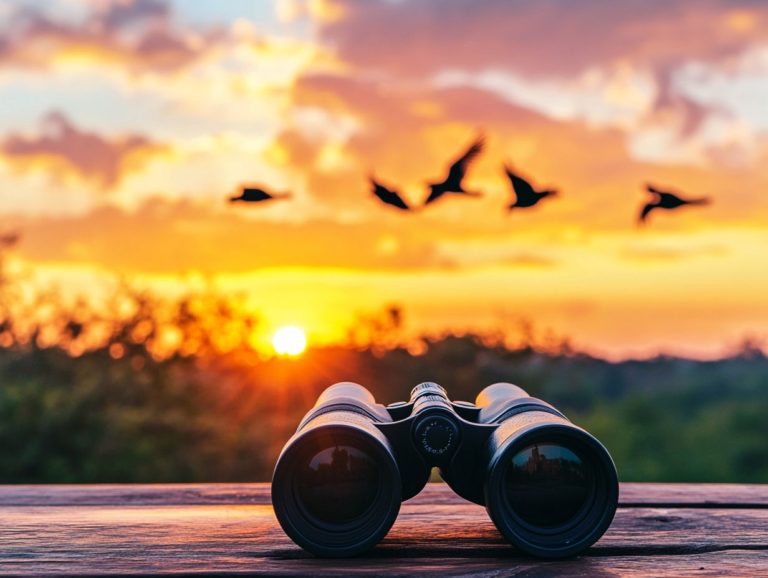The Role of Magnification in Bird Watching Binoculars
Bird watching is an enchanting hobby that allows you to immerse yourself in nature and observe wildlife in its natural environment.
One pivotal element that can elevate your experience is the magnification provided by binoculars. Grasping the nuances of magnification, knowing how to measure it, and considering the various factors when selecting binoculars can truly transform your outings.
Get ready to discover the amazing benefits of higher magnification! This article delves into the advantages and limitations of higher magnification, offers insights for achieving stable viewing, and equips you with the knowledge to maximize your bird-watching adventures.
Contents
- Key Takeaways:
- The Importance of Magnification in Bird Watching
- Understanding Magnification in Binoculars
- Choosing the Right Magnification for Bird Watching
- Benefits of Higher Magnification
- Improved Detail and Clarity
- Drawbacks of Higher Magnification
- Tips for Using High Magnification Binoculars
- Frequently Asked Questions
- What is the role of magnification in bird watching binoculars?
- What do the numbers on binoculars represent?
- What is the recommended magnification for bird watching?
- How does magnification affect the field of view?
- Does higher magnification always mean better image quality?
- Can I use binoculars with different magnifications for bird watching?
Key Takeaways:
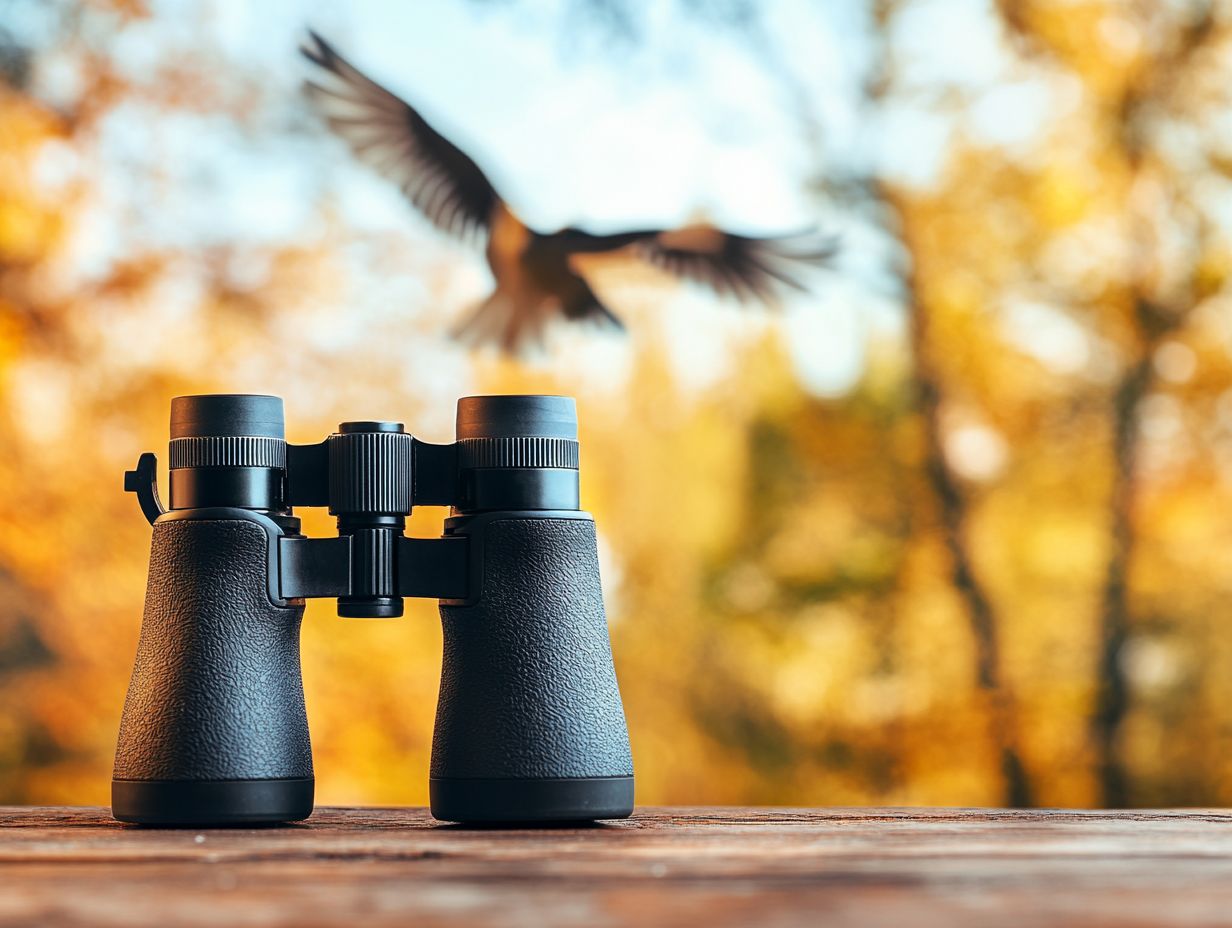
- Magnification greatly enhances the bird-watching experience, allowing for clearer and more detailed views of birds in their natural habitats.
- Understanding how magnification is measured and choosing the right level for bird watching is crucial in selecting the best binoculars for this hobby.
- While higher magnification offers improved detail and clarity, it also comes with drawbacks such as stability and a smaller field of view. Consider these factors when choosing the right magnification for bird watching.
The Importance of Magnification in Bird Watching
Magnification is essential for elevating your bird-watching experience, allowing you to immerse yourself in the intricate details of birds in their natural habitat. To enhance this experience, it’s important to understand the importance of binoculars in birding. Whether you opt for binoculars with configurations like 8×42, 10×42, or 8×32, the level of magnification can dramatically influence the clarity and quality of your view.
This enhancement enables you to identify species with greater precision and truly appreciate their behaviors.
Grasping the nuances of magnification is vital to choosing the right binoculars that cater to your needs, whether you’re a casual observer or a dedicated birder. Your selection can also impact key factors such as field of view, light-gathering capacity, and overall optical quality, all of which contribute to your enjoyment of this enriching hobby.
Enhancing the Bird Watching Experience
Enhancing your bird-watching experience starts with choosing the right binoculars that elevate visibility and detail.
When you invest in high-quality options like the Swarovski EL or the Zeiss Victory SF, you’re likely to notice a marked improvement in your ability to spot and identify species.
These advanced optics come equipped with superior light transmission and minimal distortion, allowing you to fully appreciate the breathtaking plumage of birds as they flit among the branches.
Avid bird watchers often share tales of encountering elusive species and capturing stunning images that would have slipped by unnoticed without these exceptional tools.
Brands like Nikon and Vortex have designed models that offer remarkable clarity, drawing in nature lovers who frequently comment on how these binoculars have completely transformed their outdoor adventures.
Understanding Magnification in Binoculars
Understanding magnification in binoculars is crucial for you as a bird watcher, as it significantly affects the clarity and detail of the distant subjects you observe. Knowing what is the best magnification for bird watching can enhance your experience significantly.
Magnification is usually expressed as a ratio, like 8x or 10x, indicating how many times larger an object appears through the binoculars compared to the naked eye.
The lens that gathers light becomes increasingly important at higher magnifications, influencing how well you can see in different lighting conditions.
Moreover, the design of the binoculars, whether utilizing roof prism or porro prism systems, further shapes your viewing experience and overall optical performance.
How Magnification is Measured
Magnification in binoculars is conveyed through a straightforward numerical ratio. This ratio illustrates how many times larger an object appears compared to your naked eye.
This ratio is typically paired with the diameter of the objective lens. This is a crucial factor in understanding how well binoculars can gather light and provide clear images. For instance, a specification like 8×42 indicates that the binoculars provide 8x magnification with a 42mm lens. Conversely, a 10×42 designation offers a higher level of magnification, which is beneficial for observing fine details but may narrow your field of view.
Alternatively, an 8×32 model strikes a balance between portability and a wider field. This makes it ideal for bird watchers who require quick, expansive scanning of larger areas. Each magnification level carries its own practical implications, especially for those passionate about observing birds from varying distances.
Higher magnification allows you to see intricate details of distant birds. In contrast, lower magnification is advantageous for tracking fast-moving species across open landscapes.
Choosing the Right Magnification for Bird Watching
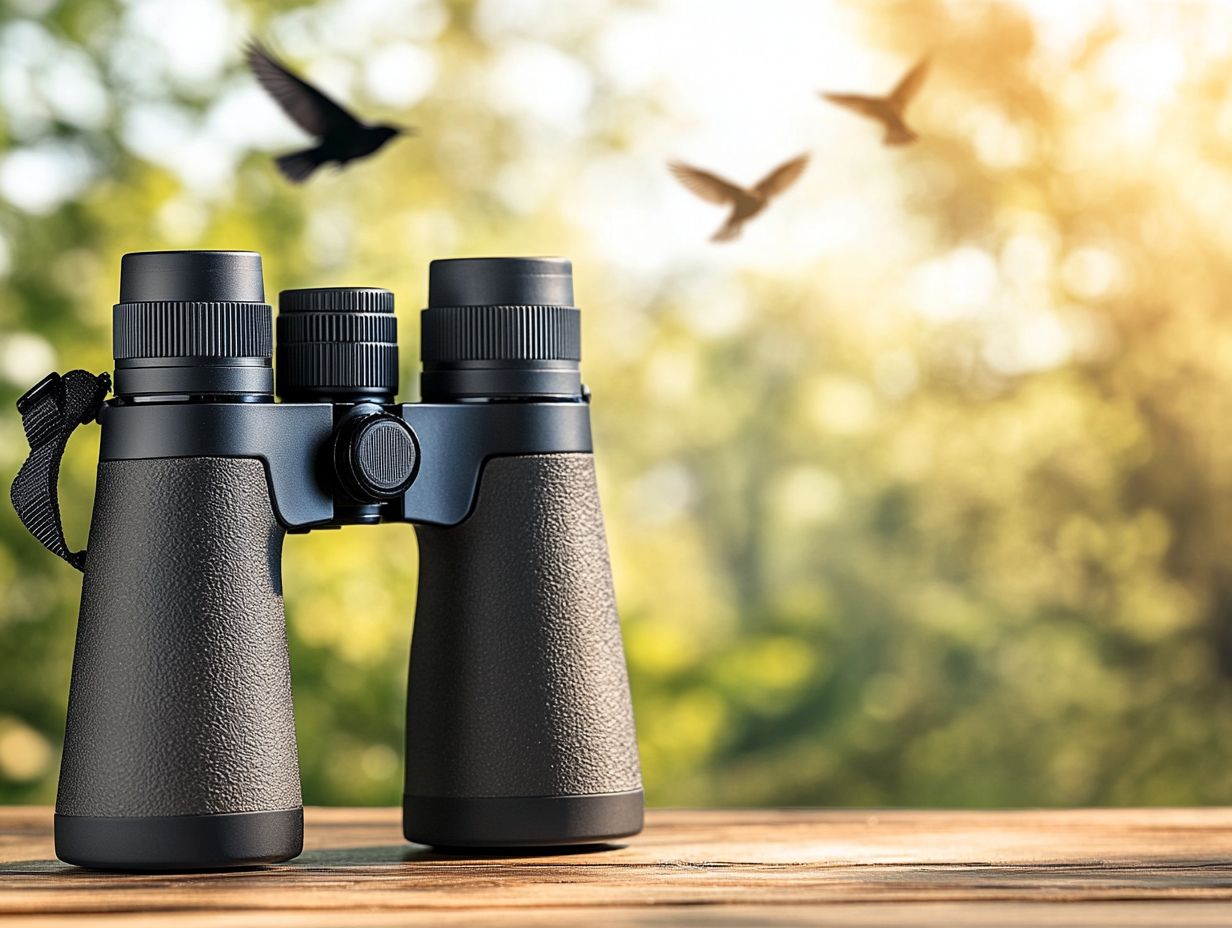
Selecting the right magnification for bird watching can enhance your enjoyment and success in spotting various species. This directly impacts the level of detail you can appreciate.
Consider several factors when choosing binoculars: the typical distances at which you observe birds, the conditions in which you ll be using them, and your personal preferences regarding weight and portability.
While high magnification binoculars can deliver breathtaking detail, they often come with trade-offs. These include a reduced field of view and the need for a steady hand or tripod support. Understanding these variables is essential for making a well-informed choice.
Factors to Consider
When selecting binoculars for bird watching, consider several critical factors to ensure an optimal viewing experience.
The most vital element is magnification power, which allows you to observe distant birds in stunning detail. The field of view is also important, helping you track fast-moving creatures with ease.
Another key aspect is close focus ability, enabling you to appreciate nearby species with remarkable clarity. Don t overlook the weight of the binoculars; lightweight models can make long observation sessions far more comfortable.
Consider options like the Nikon Monarch 5 and the Vortex Diamondback. These models combine essential features, elevating your bird-watching experience with the precision and comfort you seek on your explorations.
Benefits of Higher Magnification
Using higher magnification in binoculars provides bird watchers with numerous advantages. It significantly enhances the detail and clarity of distant birds, but it’s also important to consider understanding field of view in birding binoculars for a well-rounded experience.
The most remarkable benefit is your ability to accurately identify species, even from considerable distances. This allows you to develop a deeper appreciation for avian behavior and characteristics.
Higher magnification binoculars excel in low-light conditions. They are especially essential during the early hours of dawn or the twilight of dusk when many birds are most active.
Advancements in optical technology have improved the quality of high-magnification models. This results in sharper images and enhanced color fidelity, making your birdwatching experience truly exceptional.
Don t miss out! Explore recommended binocular models and start your birdwatching journey today!
Improved Detail and Clarity
Using higher magnification binoculars for bird watching offers remarkable improvements in detail and clarity.
With enhanced magnification, you can observe intricate feather patterns, vibrant colors, and even subtle movements that the naked eye might miss.
Imagine this: with 10x magnification, you spot the delicate plumage of a goldfinch perched in a distant tree. Meanwhile, a friend equipped with standard 8x binoculars is left squinting or moving closer just to catch a glimpse of the same beauty.
Enthusiasts rave about this advantage. One birder noted that switching to higher magnification transformed their experience, enabling them to differentiate between the calls of similar species based on visual details they had previously overlooked. This heightened clarity invites a deeper appreciation for the bird world.
Drawbacks of Higher Magnification
While higher magnification in binoculars provides you with enhanced detail, be aware that it also brings certain drawbacks that every bird watcher should keep in mind.
Stability and Field of View
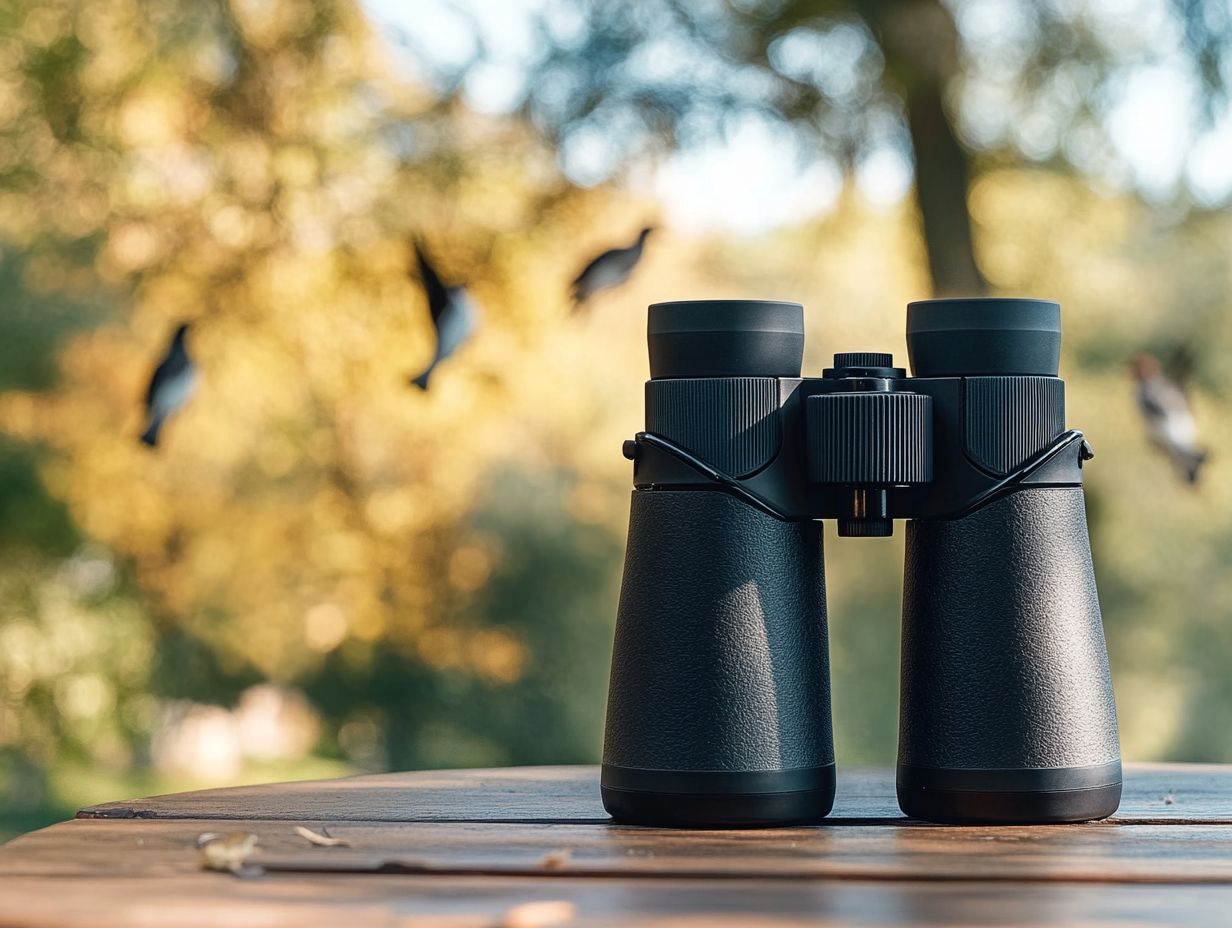
Stability and the area you can see through your binoculars are essential elements to consider when using higher magnification binoculars for bird watching.
When you choose to increase magnification, you step into a more intimate world of avian life. However, this enhanced zoom can present significant challenges, especially if your image isn t adequately stabilized. Even the slightest hand movement can transform a clear view into a shaky blur, making it difficult to spot those elusive feathered friends.
Balancing the intimacy of high magnification with the need for a steady image can be a real conundrum, as a narrower field of view may limit your chances of catching birds in motion.
Investing in a sturdy tripod or a specialized harness for your binoculars is wise to maintain stability. Adopting a relaxed stance or resting your elbows on a stable surface can significantly enhance your bird-watching experience, allowing you to immerse yourself in the beauty of nature without the distraction of erratic movements.
Tips for Using High Magnification Binoculars
To use high magnification binoculars effectively, employ specific techniques and tips that ensure a steady viewing experience. This is particularly vital for bird watchers who aspire to spot and identify birds with precision.
Techniques for Steady Viewing
When using high magnification binoculars for bird watching, mastering techniques for steady viewing becomes essential. Even the slightest movement can result in a shaky image, making it difficult to spot and identify birds in their natural environment.
Adopting a comfortable posture, like sitting or leaning against a stable surface, can significantly reduce unintended motions. Controlled breathing is key; by taking slow, deep breaths, you help maintain focus and minimize body movement.
For those truly dedicated to enhancing their bird watching experience, integrating accessories like stabilizers or harnesses can drastically improve steadiness. These tools offer physical support and enable you to enjoy longer viewing sessions without fatigue, ultimately leading to a more immersive and enjoyable observation experience.
Frequently Asked Questions
What is the role of magnification in bird watching binoculars?
Magnification helps you see distant birds larger, making it easier to spot details.
What do the numbers on binoculars represent?
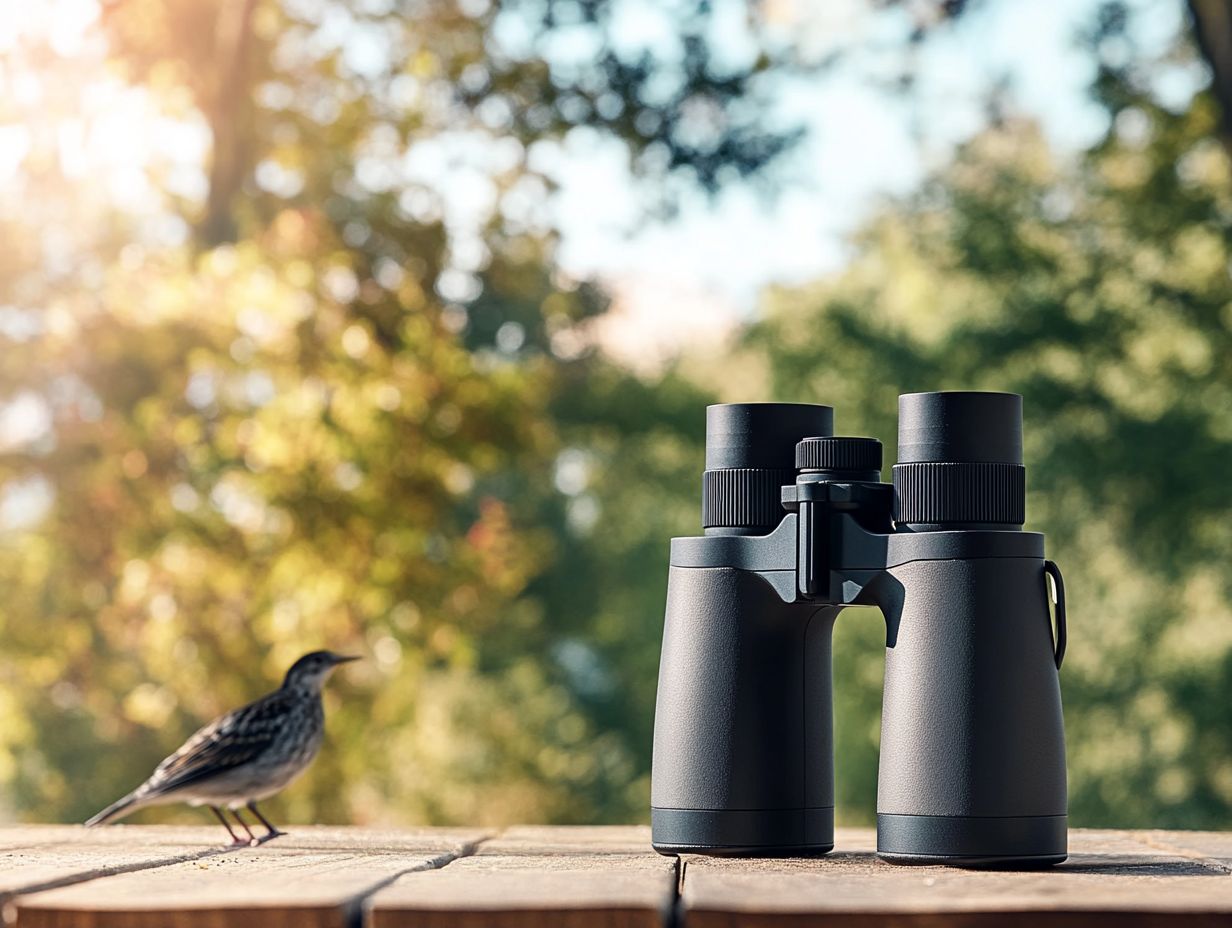
The numbers on binoculars represent the magnification power and the size of the objective lens. For example, 8×42 binoculars have a magnification power of 8x and an objective lens diameter of 42mm.
What is the recommended magnification for bird watching?
The recommended magnification for bird watching is typically between 8x and 10x. Higher magnification can make it difficult to maintain a steady image and may result in a smaller field of view.
How does magnification affect the field of view?
Higher magnification narrows the field of view. This can make it harder to locate and track birds.
In contrast, lower magnification offers a wider field. This makes it easier to scan for birds.
Does higher magnification always mean better image quality?
Higher magnification doesn’t always guarantee better image quality. The lenses, prisms, and binocular stability are just as crucial.
Can I use binoculars with different magnifications for bird watching?
You can use binoculars with various magnifications for bird watching. However, switching between them can be tricky since the field of view and image size change.
For the best experience, it’s wise to stick with one pair of binoculars that have consistent magnification.


